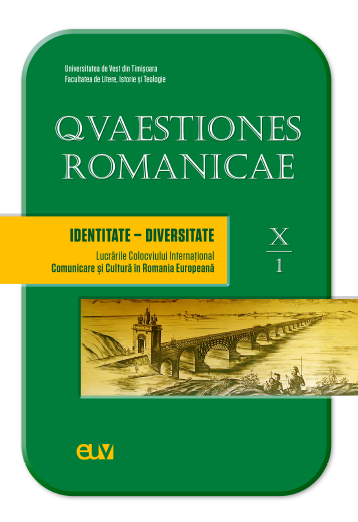Inducția metaforică în discursul poetic
Abstract: (Metaphoric induction in poetic discourse) The mechanism of metaphorical induction, detailed in Eugen Dorcescu’s studies of metaphor, provides a peremptory argument for the equivalence between the trope of tropes and discourse. The identification of living metaphor with discourse is the fundamental principle that guides the research of this figure by Paul Ricoeur. For us, the possibility of equating the two notions (metaphor and discourse) constitutes a working hypothesis in the approach of spun out metaphors. These broad metaphorical structures will prove that metaphor can generate a special type of discourse, infiltrating its logic, semantics and syntax and increasing its aesthetic value. If we accept that a literary discourse / text is distinguished from all those made up of linguistic signs by its aesthetic value, we will also accept that metaphor, through presence and reverberation, ensures the specificity of such a discourse. Therefore, we will demonstrate that noun metaphor induces verbal / adjective / participle / adverbial metaphors in discourse, establishing a network of interrelated figurative meanings, also increasing / multiplying the syntactic structures necessary for the development of the idea / ideas conveyed, in 25 conditions of progressive compatibility of co-textual, coherent elements. Spinning metaphors, which, according to H. Suhamy, develop, predictably or unpredictably, a guiding theme or even more, go beyond the scope of the sentence and fit, in countless variants, into broad discursive structures. Their analysis in Romanian poetry will allow the illustration of various springs of cumulative metaphorization, which ends up encompassing the entire lyrical discourse. Most frequently, the spun metaphors represent the consequence of some semantic-stylistic inductions, exerted especially on some predicate-verbs which, being themselves metaphors, widen the metaphorical area until the overlap with poetry.
Keywords: metaphor, induction, equivalence, poetic discourse, spun out metaphors.
Rezumat: Mecanismul inducției metaforice, detaliat în studiile despre metaforă ale lui Eugen Dorcescu, oferă un argument peremptoriu pentru echivalența dintre tropul tropilor și discurs. Identificarea metaforei vii cu discursul este principiul fundamental ce orientează și cercetarea acestei figuri de către Paul Ricoeur. Pentru noi, posibilitatea echivalării celor două noțiuni (metaforă și discurs) constituie o ipoteză de lucru în abordarea metaforelor filate. Aceste ample structuri metaforice vor proba faptul că metafora poate genera un tip special de discurs, infiltrându-se în logica, semantica și sintaxa acestuia și sporindu-i valoarea estetică. Dacă acceptăm că un discurs/text literar se distinge de toate cele alcătuite din semne lingvistice prin realizarea sa estetică, vom accepta și că metafora, prin prezență și reverberație, asigură specificitatea unui asemenea discurs. Astfel, vom demonstra că metafora substantivală induce în discurs metafore verbale/ adjectivale/ participiale/ adverbiale, stabilind o rețea de semnificații figurate interrelaționate, dar și augmentând/ multiplicând structurile sintactice necesare dezvoltării ideii/ideilor vehiculate, în condiții de compatibilizare progresivă a unităților co-textuale, de coerență. Metaforele filate, care, în accepțiunea lui H. Suhamy, dezvoltă, în mod predictibil sau impredictibil, o temă directoare sau chiar mai multe, depășesc cadrul propoziției și se înscriu, în nenumărate variante, în structuri discursive ample. Analiza acestora în poezia românească va permite ilustrarea a diverse resorturi ale metaforizării cumulative, ce ajunge să cuprindă întregul discurs liric. Cel mai frecvent, metaforele filate reprezintă consecința unor inducții semantico-stilistice, exercitate îndeosebi asupra unor verbe-predicat care, metaforizate fiind, lărgesc aria metaforică până la suprapunerea cu poezia.
Cuvinte-cheie: metaforă, inducție, echivalență, discurs poetic, metafore filate.
